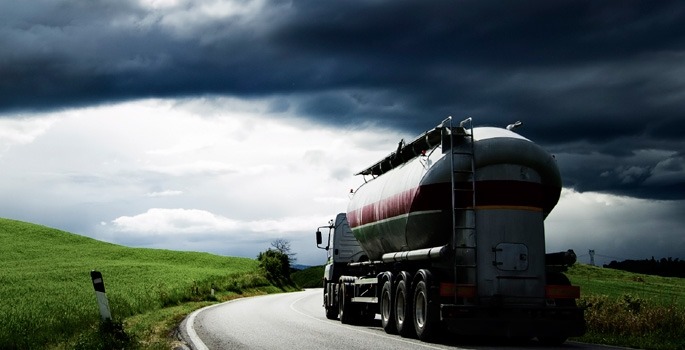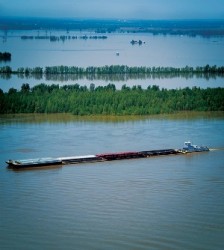
Despite the uncertainties surrounding climate change, it is time to start developing effective strategies that will keep the nation’s transportation systems and other critical infrastructure running in the face of the adverse impacts that seem increasingly likely to occur.
This consensus emerged from a two-day leadership summit that brought together major stakeholders from the $1 trillion-plus freight transportation sector with climate change researchers to discuss the issue for the first time. The meeting was held in June at Vanderbilt University and was sponsored by the Vanderbilt Center for Transportation Research (VECTOR), Vanderbilt Institute for Energy and Environment (VIEE) and the University of Memphis’ Intermodal Freight Transportation Institute.

“It is increasingly clear that climate change will have potentially large impacts on the nation’s highways, railroads, waterways, airports and pipelines. In all likelihood, these impacts will increase in the future, so we have to learn how to plan ahead,” said George Hornberger, director of VIEE and distinguished professor of civil and environmental engineering.
Infrastructure damage on the rise
According to the University Center for Atmospheric Research, more than 75 percent of natural disasters are triggered directly or indirectly by weather and climate. In the U.S., more than a quarter of our gross national product (+$2 trillion) is sensitive to weather and climate events, which affect our health, safety, economy, environment, transportation systems and national security. Each year, the U.S. sustains billions of dollars in weather-related damages caused by hurricanes, tornadoes, forest fires, flooding, heavy snows and drought. The threats associated with extreme weather and climate change are substantial and adapting to climate change will be crucial to economic and social stability, for example by making future water, food and energy supplies reliable and sustainable. Contributing to these costs is the problem of the nation’s aging infrastructure, which needs $2.2 trillion in improvements to meet today’s demands, according to the 2009 National Infrastructure Report Card by the American Society of Civil Engineers.
Unless the nation begins taking appropriate measures, these costs are likely to increase: “It appears to us that more extreme weather events – like floods and hurricanes – are becoming more frequent and pronounced and [rquote]we need to be prepared to adapt to the prospect that what have been episodic events in the past become chronic features of our operational landscape in the future[/rquote],” observed Craig Philip, Chief Executive Officer of the Ingram Barge Company and a member of the conference steering committee.

The Mississippi River floods in April and May, which were among the largest and most damaging recorded along the waterway in the past century, the flooding on the Missouri that began in June and the above-average wildfire season that burned 1.3 million acres in the month of June in the Southern Plains and Southwest, are dramatic examples of the kinds of natural disasters that experts predict will become increasingly severe and frequent.
“Right now people are waking up to the fact that they will have to adapt, but very few are walking the walk,” commented Mark Abkowitz, co-organizer of the meeting and professor of engineering management at Vanderbilt. “If we’re not careful and begin taking action soon, we will fall so far behind that playing catch-up will be difficult.”
Reasons for current lack of action
The summit discussions identified several reasons for the current lack of action: 1) uncertainty in the timing and magnitude of climate change; 2) insufficient knowledge of how these changes will impact the performance of critical infrastructure systems; 3) the succession of short-term crises that deflect attention and resources; and 4) lack of political leadership.
So far, the federal government has focused almost exclusively on mitigation: developing

methods that reduce the amount of carbon dioxide released in various industrial processes or sequestering carbon deep underground.
“Regardless of the success of mitigation efforts, we will need to adapt. Even if we could completely stop injecting more carbon dioxide into the atmosphere, the concentration of carbon dioxide is already significantly higher than historic levels so we would still have to handle the consequences,” said Hornberger.
Key initiatives for next five years
Summit delegates identified several key initiatives that should be undertaken in the next five years:
- Identify the critical infrastructure that is most vulnerable to damage and disruption. Of particular importance are bridges, highways, rail lines, airports and other key transportation facilities for which there are no alternatives
- Assess the cost of impacts to key infrastructure components. Putting a dollar sign on the potential damage for non-action helps determine the benefits of the proposed protective measures
- Develop better tools and models for performing risk assessments. Right now the climate models are more accurate at the global and regional scale, but they are not capable of predicting the local effects that planners need
- Define and communicate climate change problems in terms that decision makers can understand
- Improve dialogue and collaboration among stakeholders.
“There is no reason why we should wait to get started down this path,” said Abkowitz. “As long as our approach remains flexible, we can adapt as better information becomes available.”
Videos of the plenary sessions of the meeting can be viewed on the Vanderbilt School of Engineering’s website.